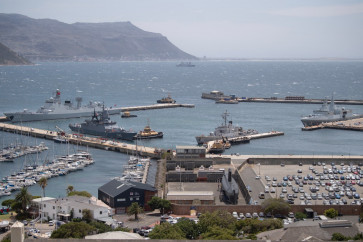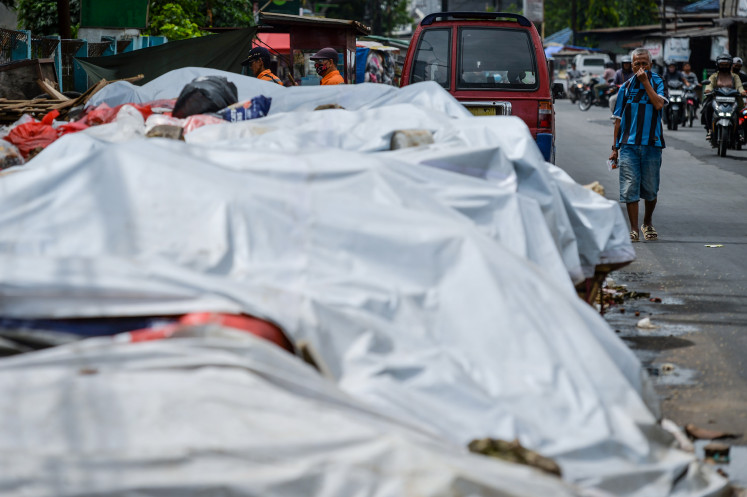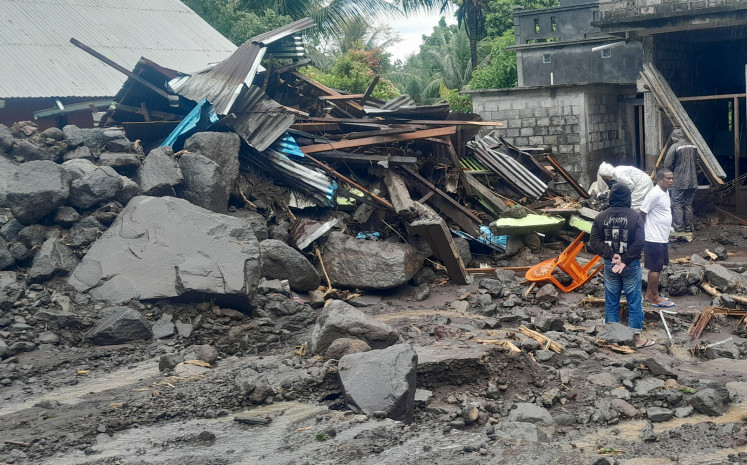Popular Reads
Top Results
Can't find what you're looking for?
View all search resultsPopular Reads
Top Results
Can't find what you're looking for?
View all search resultsDream of an Acehnese painter
The studio is as big as a garage
Change text size
Gift Premium Articles
to Anyone
The studio is as big as a garage. It is located under a single family’s home in a quiet residential neighborhood in northern Virginia, just outside Washington, DC.
In fact, it once was really a garage that was converted into a neat, but sparsely furnished room. There is a big computer monitor, the only sign of high technology other than a cellular phone, and some paintings on the walls.
Nothing else is special except for a big half-finished painting —a little too big for the room— that greets visitors when they entered the studio. The painting is an oil-on-canvas portrait of the next president of the United States of America.
Acehnese Machyar Mustafa Gleunta poses for a photograph in front of his painting of US President-elect Barack Obama, at his studio in Virginia. (JP/Yenni Djahidin)
“I was so inspired by Barack Obama’s speech in New Hampshire during the primary election,” said Machyar Mustafa Gleunta, an artist from Indonesia who lives in Virginia. From then on he said he knew that Obama is a different kind of politician.
“He gives hope to people, not only for Americans, the hope that we can change ourselves if we make up our mind,” Machyar said.
“Maybe the idea is not new, but I thought it’s very unique,” he said of Obama’s speech.
The 37-year-old artist said he was so moved by what he heard that he immediately started a sketch of Obama. He said an American organization commissioned the painting, but he is not allowed to reveal the organization until the painting is ready to be displayed.
The 70x60 inches portrait shows Obama writing at a desk by a big window overlooking the US Capitol building. “I’m still working on it. The painting is very complex but I want to finish it by the end of the year,” Machyar said during an interview conducted solely in English, a language he used to get a scholarship in the United States.
Born in the small village of Matang, Glumpang Dua, in Aceh, Machyar grew up in a modest household. His father is a carpenter. His stay-at-home mother designed and sewed her own clothes.
“When I was about five years old, I always looked at books and the pictures jumped at me,” he said of his first interest with pictures and paintings. “I started to draw and make sketches with colored pencils because we didn’t even have crayons in the house,” he said.
Machyar said he was so attracted to drawing that he decided to enter a technical high school hoping to become an architect. However, he said, the school didn’t suit him very well. So, he kept painting, this time pictures of landscapes and other aspects of daily life.
“I was able to sell the paintings and support myself as a teenager,” he said. That’s when Machyar realized that painting can be a profession and he wanted to learn more about it. He took tests to enter public universities four times and he failed them all.
“In a way, it was good that I failed the tests,” he said with a smile. Machyar studied English privately and was able to get a 500 points score on TOEFL, a standard test. With the TOEFL test score, he started sending inquiries to foreign embassies in Jakarta and seeking information about scholarships. After two years, he finally received a response from the United States embassy.
“AMINEF said they would try to help me,” Machyar said. Trying is the best word to describe his next effort to win a scholarship. AMINEF, short for the American Indonesian Exchange Foundation, provides, among others, the Fulbright Program to promote mutual understanding between Indonesia and the United States through educational exchange and academic scholarship.
Machyar said he went to AMINEF’s office everyday and talked to visitors from the States, including businessmen and academia. He told them his intention to seek a scholarship in the United States.
“After two years, I finally received two offers: One from a university in Maryland and one from Maine,” he said. He finally decided to take the offer from Maine College of Art, in Portland, Maine, where he studied for two years. After that, he continued his studies at the Pennsylvania Academy of Fine Arts in Philadelphia, where he studied more about neo-classical style.
Machyar’s paintings are realistic, some with subdued color. Some of them also show the flag of the Aceh’s freedom movement (GAM). In fact, he said, that while studying in Philadelphia, he was also involved in an advocacy group to promote human rights in Aceh. He said he was concerned about the military treatment of Acehnese.
“When you talked to the military personnel, one on one, they agreed with your ideas, but when they are in the war zone, they forgot that we are brothers,” Machyar said.
He also said he is happy with current developments in Aceh and lauded the policies of President Susilo Bambang Yudhoyono.
“We just hope that the conditions in Aceh will get better and better,” he said.
Machyar said his parents and family are still living in Aceh. He choked up a little bit when he talked about his family. “I miss them very much. I haven’t seen them for 12 years. It’s been very hard not to be able to see them for such a long time” he said.
His parents’ house does not have a telephone or electricity so it is hard for him to communicate with them.
Living as an artist is not as glamorous as it looks. Like many young artists, Machyar struggled to support himself in a foreign country. He said a disciplined life helped him.
“Artists have to do whatever to survive as an artist. Painters are no exception,” he said. He explained that his work is fine arts and not mass produced commercial paintings. He declined to say how much his paintings are worth, but added that he earned enough to be able to survive.
“A painting business is very unpredictable. Sometimes, it takes years to close one sale,” he said. “But I have to keep painting. I have to do whatever it takes to survive, including working at a construction site,” he added.
“The real price of art is priceless,” Machyar said. “There is no limit to the value. People can pay, say, 1 thousand dollars for my work, but in two years the price may go much higher,” he said.
Four years ago, Machyar was commissioned to do a portrait of the civil rights leader and former American ambassador to the United Nations, Andrew Young.
Machyar is now married to an American woman. They are hoping to settle in Virginia and visit his family in Aceh. He is now in the process to become a US citizen. Still, he said he has a dream.
“I want people to know that you should set your dream high,” he said philosophically.
“However, if you miss it, it’s not a big deal,” he added quickly.
When asked if he has achieved his goal, Machyar said his goal has expanded.
“I have achieved what I expected in Aceh, but my goal has expanded,” he said, but declined to elaborate. Later, he said that he wanted to have his own studio when he and his wife are able to fund it.
With the American presidential inauguration only a week away, there is frenzy in Washington to get a glimpse of the incoming president and his family. Still, Machyar hopes he would be able to present the painting to Obama personally when the commissioning organization makes a final decision about where to display the painting.
Like many others, Machyar also hopes President Obama can make positive changes in the world. “Obama’s speech is not only for America. It transcends to all groups worldwide,” he said.
“I hope this administration will change how the American government does things,” he said, adding that he can connect very deeply to Obama’s story and share a similar dream.
On the Net: www.MKFineArts.com










